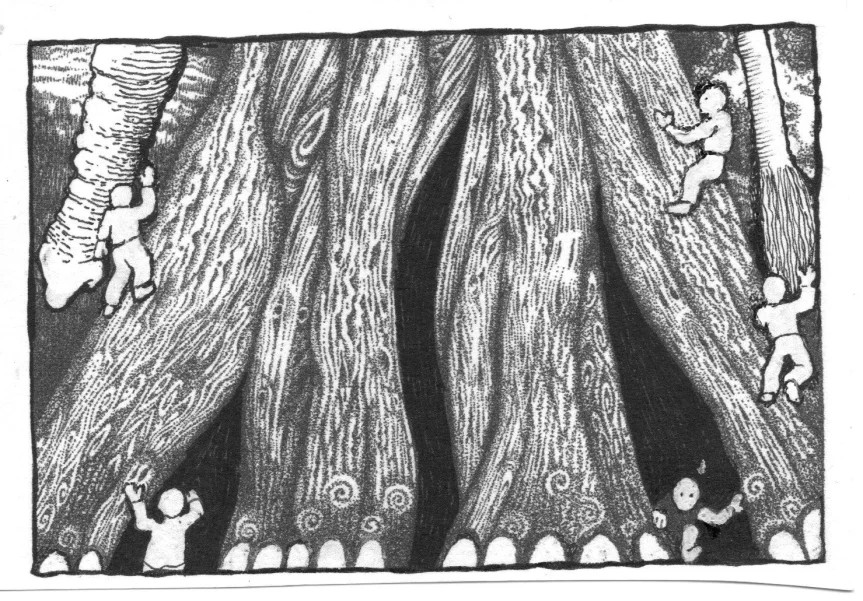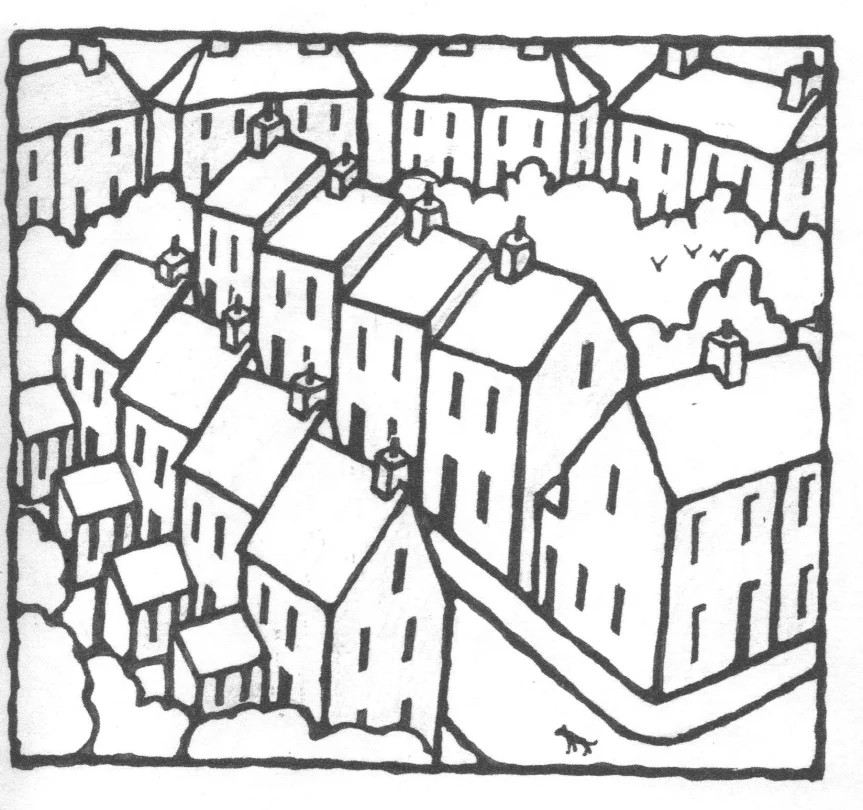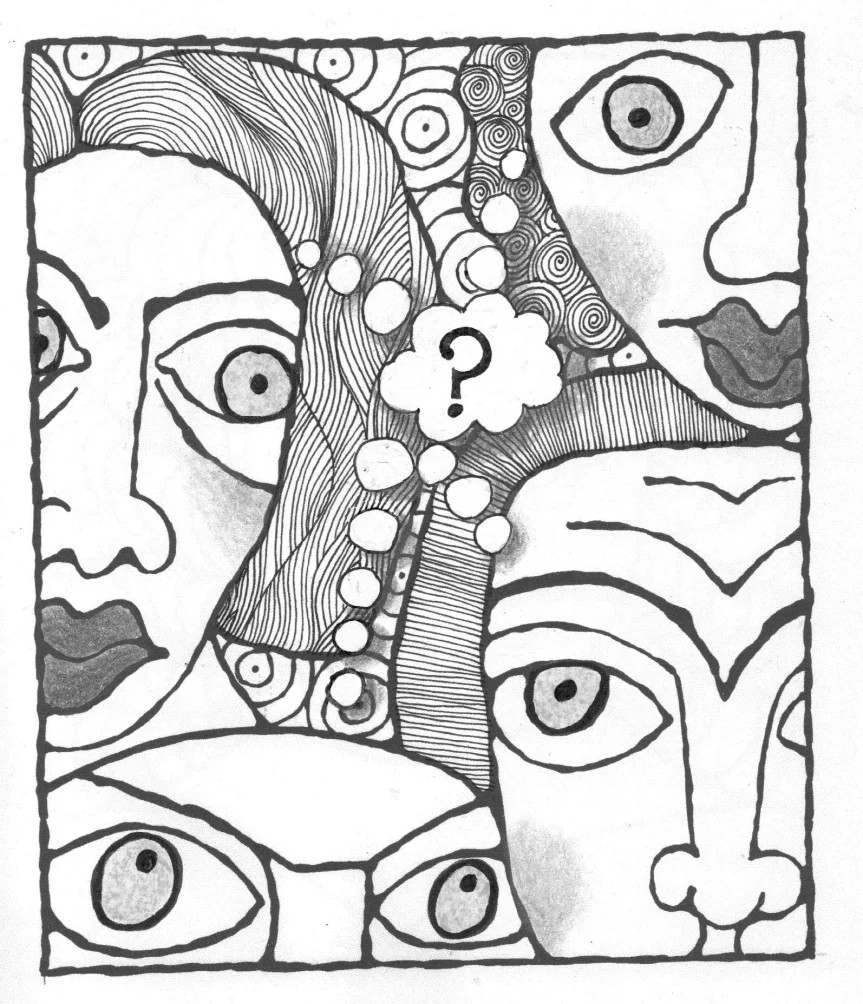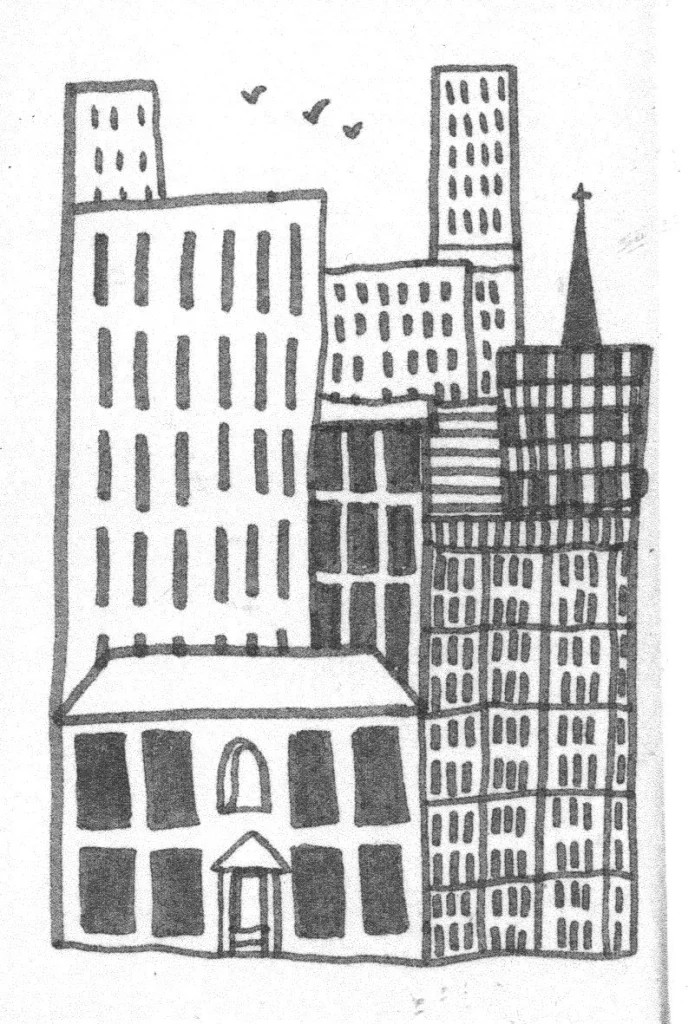NE has made frequent references to psychogeography, a hydra-like conceptualisation of people’s interaction with place. Often seen as an urban pastime with origins in a post-war Marxist milieu, John Billingsley here explores how it is also pertinent to rural and traditional cultures and communities, and bears a clear connection with earth mysteries and the wider application of phenomenology.
The title is of course a conceit. It’s a customary header used by purveyors of information, such as a magazine like this. You are invited to assume that the ‘we’ is Northern Earth, and that assumption is right. But the ‘we’ is an Editorial We, cousin to the Royal We, and is the customary presumption of the editor, the navigator of the vehicle. Do the rest of the NE team see it this way? I’ve no idea. We’ve talked about it, and agree that psychogeography and phenomenology are part of the earth mysteries/neo-antiquarian atlas, and an area that hasn’t been explored in our publications nearly enough; but the keenest advocate is me, the editor. I’m the one who’s supposed to have a working map.
We’ve run several articles on the topic, but still readers ask ‘what is psychogeography?’ [1] And I’ve balked at answering, because psychogeography is Hydra-like, or, if you prefer your beasts less fantastic, like the elephant that the blind witnesses attempt to describe from their individual tactile perspectives. Psychogeographers have their own ways of doing things, and for some factionista, others’ ways are simply not psychogeography at all. [2] We can safely say that they’re mistaken, because today we can see and acknowledge that psychogeography encompasses all praxis that in itself challenges the pre-programmed provision and limitation of space, understood geographically or conceptually. It’s a broad umbrella. There’s space there for art, psychology, revolutionary action, theatre, town planning, geography, place legends, obtuse and verbose intellectualisations and much more, and we’ll interact with this head or that other part of the elephant we choose.
I don’t really need to describe the genesis and history of psychogeography – which is only the genesis of a word, anyway, not of the phenomenological perspective that is at its root. I don’t have to abide by its customarily-acclaimed theorists like Debord and Lefebvre, or practitioners like Keiller and Sinclair. I do not have to insist on its subversive and viral nature, nor on its Situationist or Marxist penchants. I can step out of the urban landscapes that are the dream-within-nightmare scenarios of many contemporary psychogeographers. I can reject the obfuscatory vocabulary of postmodern theses and ivory-tower underpinnings. All of that is available elsewhere from people clutching their own bit of elephant hide. I have my bit.

And this is psychogeography as I see it (at least, at the moment), and thus, for the time being, as NE sees it; psychogeography as we understand it to impinge on the customary playgrounds of earth mysteries (another Hydra-elephant, if it comes to that). I do not intend this as definitive, but descriptive of a way of seeing, recognising and communicating with place – as something of an answer to those who have asked the ‘But what is?’ question. Maybe others would like to contribute their own answers too.
Psychogeography is a post-war thing rooted in the urban political and economic expression. That’s been the general impression, and most of the work has been with such townscapes. But why should the countryside not have its psychogeography? And why should it be a post-war thing? And why should it be informed by modern ideologies? Our take on this is to engage not just with the contemporary urban experience of globalised programmed space – the Spectacle, as it’s often termed by those with the jargon – but also with the rural experience of psychogeography, and prehistoric psychogeography, i.e. psychogeography before the Situationists gave it a name, and with psychogeography in an incarnation as an allusive quasi-mythical understanding of place and our routes through and within it.

This places it within the purview of phenomenology (the definition sof these two terms surely imply their relevance to earth mysteries interests) [3], another area we have repeatedly touched upon with our tentacular e.m. reach – I might attempt to précis it, however clumsily, for our particular application as ‘the meaning we retrieve from or ascribe to places’, which is another way of saying making sense of our surroundings. We do it as children or adults in cognitively mapping – and by-naming – our familiar haunts (itself a phenomenological/psychogeographical usage), and we underscore it in anecdotal narrative. We do it as earth mysterians or archaeologists by aiming to comprehend the elements inherent in the landscape comprising an ancient site. [4] We do it as folklorists, I would argue, by looking behind testimonies of experience at a place.
The key praxis in psychogeography is the dérive, or drift: an unplanned walk, directed by spontaneous attraction to routes and places. In the process, one thing we will discover is how our routes are mapped out and chosen for us by roads and private property signs and suchlike – from such experience in an urban context, Guy Debord concocted the dérive as a subversive act, undermining the psychological controlling effect of officially sanctioned routes and vistas and experience of place, and thereby the concrete basis of power. Debord’s clique and psychogeographers after them have thus focussed on psychogeography as an urban and materialist praxis; but note Debord’s words from 1955: “The sudden change of ambience in a street within the space of a few metres; the evident division of a city into zones of distinct psychic atmospheres; the path of least resistance that is automatically followed in aimless strolls (and which has no relation to the physical contour of the terrain); the appealing or repelling character of certain places…” .[5] What is there in this quote that cannot be transposed geographically, to a rural setting: a lane for a street, a valley for a city? Or psychologically: atmosphere, character? The experience he described is one that is familiar to me – and I suspect to other neo-antiquarians – as a walker, an antiquarian and a folklorist, but through my own choice of surroundings it is familiar from the countryside.
It may also have been familiar to the poet John Clare (1793-1864). Certainly Clare was familiar with (and sorely suffered from) the packaging up of open fields and landscapes into enclosed parcels which somehow the rich and powerful got the best of, and which drove the rural poor into the emerging and unlovely cities of the new Industrial Revolution – the kind of streets that appalled Friedrich Engels [6] and 150 years later enspasmed Debord’s critique: i.e. the founding experience of modern psychogeography was spawned by practices such as those expressed in the countryside by England’s Enclosure Acts. Indeed, the classic figure of psychogeography, the flâneur, was conceived not by Debord but by Baudelaire around 1863, as “a nostalgic figure symbolising not only the birth of the modern city but also the destruction of his former home”. [7]
Clare, increasingly barred from the heaths and woods where he once rambled relatively freely, [8] recognised the political side to the changes in his East Anglian landscape:
Inclosure came and trampled on the grave
Of labours rights and left the poor a slave …
Fence now meets fence in owners little bounds
Of field and meadow large as garden grounds
In little parcels little minds to please
With men and flocks imprisoned ill at ease
Each little path that led its pleasant way …
These paths are stopt – the rude philistines thrall
Is laid upon them and destroyed them all… [9]
The same process of channelling progress and passage, and all its psychological and phenomenological ramifications, was present in the countryside as well as in the city. Parcelled and private fields meant walls between property and the people who were passing from one place to another. Where landscapes might once harbour straight(ish) desire paths, post-Enclosure people were increasingly directed where to go, and the encounter with ambience was restricted to one’s allowance. This is one way the psychogeographical perspective can relate to rural contexts and potentially inform earth mysteries understanding, particularly of leys and other alignments. [10]
The deliberate remapping of the landscape, in urban or rural planning, is a remaking of history, or more accurately of culture, and tends towards inducing forgetfulness of what went before, especially in societies like the present, which sets such store on novelty. It’s understandable if we can barely, if at all, comprehend the meaning of prehistoric monuments, but it isn’t so different from our general bafflement when confronted by a piece of agricultural machinery rusting away in a field – for many, they become art objects like Dadaist ‘readymades’ rather than windows into the relatively recent rural past, just like spectacular ancient sites are presented for the needs of a tick-box tourist industry.
Debord put this displacement of history into a psychogeographic/Situationist context: “History’s domain was the memorable, the totality of events whose consequences would be lastingly apparent. And thus, inseparably, history was knowledge that should endure and aid in understanding, at least in part, what was to come… In this way, history was the measure of genuine novelty. It is in the interests of those who sell novelty at any price to eradicate the means of measuring it”. [11] His point is that contemporary society finds it helpful to downplay historical knowledge in general in favour of the immediate, encouraging ignorance or romantic guesswork in place of knowledge – what in 2017 US politics we learned are ‘alternative facts’. Remade histories and cultures have decided for us what is worth remembering, and what they would like us to disregard or mis-see – which is where the neo-antiquarian could do with a new way of seeing.

So the political implications of the psychogeographers’ rationale apply to the rural as to the urban. But what about Debord’s reference to the deeper psychological affect – “the appealing or repelling character of certain places”? In my own work on place legends [12] and in much place-related folklore I have noticed how anecdotal folk narrative, often of a supernatural or quasi-mythical nature, speaks of the perceived nature of a place – for instance, whether a place is said to be the abode of fairies, boggarts or hobthrusts, all of which have their particular nature and relationship with humans.
Place-names also fix in the landscape certain impressions associated with them by past generations, perhaps memorialising a local story no longer known or told – places called Boggart Nook or Fairy Bridge, for instance, would have required caution equally, but each according to the understanding of that folkloric (but perceived as very real) figure. A quite different impression is given by a farm named, say, Throstle Bower. A name like World’s End, common in districts where one’s worldview was perforce limited pretty much to the horizon or parish, tells us something about past perceptions as well as realities. Funeral paths once known by names like Coffin Lane – invariably renamed, beautified and anonymised, from the 19th century onwards because of changing sensibilities to the narrative of life – and lore associated with them (like hauntings, or the belief that the passage of the dead across land hallowed that route as a public right-of-way) are as much a part of perception and ambience as of local history.
Names and narratives, then, are a key to the cognitive local maps, the phenomenology of past generations who, especially pre-Enclosure, were more rooted in their landscape and familiar with its various ambiences: they offer loric archaeology, albeit with a certain difficulty in empirical assessment. Familiarity with local place legends gives us a glimpse into the psychogeography of previous generations, and can in turn sensitise us to the ambiences once present – are they still present, are they blocked to us, have they been built over, are they recoverable, can they tell us about the type of place that was perceived in that way and how people interacted with their landscape in a non-economic way? The first three are in the bounds of every enquiring walker, local historian or ‘deep topographer’; recoverability is attempted by the archaeologist Christopher Tilley; and toponymist Margaret Gelling investigated the geography of perception mapped for us by namings (e.g. the plethora of words in Anglo-Saxon for ‘hill’, to denote whether it was steep-sided, barren, rolling, gently sloping or however). [13] Place narratives allow us the chance to walk in the mindways of our ancestors.
However, it doesn’t have to be all about history, or stasis in a locality. Ted Hughes’ poem cycle, Remains of Elmet, is effectively a psychogeography of his childhood in the upper Calder valley of W Yorkshire, akin to Clare’s experience of a century before. Arthur Machen fused material city and other-dimensional country in his visionary (or hallucinatory) rambles in S Wales and W London; de Quincey used hallucinogenics to access such consciousness in Paris. Artworks by Richard Long and Hamish Fulton address the psychogeographies of their movement through place. Malcolm Whitaker envisages archaeological landscapes in their layered reality, artefacts and sites rising up through soil and consciousness. And today, psychogeographers and fellow-travellers go their own way, many still fiercely (and needlessly) insisting on the urban focus, [14] but many others – as any Internet trawl will reveal – applying a psychogeographic perspective across a range of geographies and activities. They all speak to an interest in discovering a subtle meaning to place, personal or cultural, contemporary or historical, political or artistic, etc., i.e. its phenomenology – how consciousness operates on and in a place and the experiences embedded within it. As Jeff Malpas puts it, “it is through our engagement with place that our own human being is made real, but it is also through our engagement that place takes on a sense and significance of its own”. [15]
This kind of reach towards subtle understanding of place, assessing esoteric as well as exoteric associations, undermining the alienation of modern-day planned landscapes, is an approach that was present in the early earth mysteries of the 1970s. Unfortunately, the 1980s saw a fascination with earth energies and networks that some commentators later in the decade realised was little more than seeing the Earth as a version of circuit-board technology; simultaneously, the materialist implications of this perception and other developments in archaeology fostered a perception countering the materiality with a mystical pagan/New Age counterpoint. Both shifts can be interpreted as an affirmation of the dominance of media-led immediacy, what the Situationists called, appropriately, the Society of the Spectacle. Similarly, the globalisation of the 1990s was reflected in the jet-set mysteries of Graham Hancock and others – for foreign ancient wonders resurrect the allure of the exotic while enticing a taste for tourism (and harder to verify). Once again, the Spectacle turns us away from an understanding of past and local cultures as well as our place in the present.

These society-mirroring developments rather deflected e.m’s proto-psychogeographic approach, which to my mind is to be lamented; it is time to recover lost ground, and to supplement our diet of archaeology, folklore and the esoteric with explorations of the nature of place as experienced over and through time – to step off the Modern Antiquarian route map and explore a parallel world within this one – and to hopefully return from our otherworld journeys with insights for the wider world.
Notes
1. OED psychogeography: “The study of the influence of geographical environment on the mind, behaviour, etc.; geography considered in regard to its psychological effects”.
2. No names. no pack drill… they know who they are…
3. OED phenomenology: “A method or procedure … which involves the setting aside of presuppositions about a phenomenon as an empirical object and about the mental acts concerned with experiencing it, in order to achieve an intuition of its pure essence… philosophical methods or theories which emphasise the importance of analysing the structure of conscious subjective experience”. See also Note 1.
4. See Christopher Tilley, Interpreting Landscapes (Left Coast Press, 2012), reviewed NE143; A Phenomenology of Landscape (Berg, 1994).
5. ‘Introduction to a Critique of Urban Geography’, Les Lèvres Nues #6 (Paris, September 1955).
6. Engels’ classic, The Condition of the Working Class in England, constitutes a kind of mid-19th Marxist dérive around Manchester.
7. Merlin Coverley, Psychogeography (Pocket Essentials, 2006) p.20
8. And being driven out of his place helped drive Clare out of his mind.
9. John Clare, ‘The Mores’. Spelling etc. as in the original.
10. See my interpretation of the ley thesis in these psychogeographical terms: John Billingsley, ‘A New Line on the Ley’, NE99 (Autumn 2004) or on our website.
11. Guy Debord, ‘Comments on the Society of the Spectacle’, Verso 1990, p7-8. Available http://libcom.org.libcom.org/files/Comments%20on%20the%20Society%20of%20the%20Spectacle.pdf
12. Folk Tales from Calderdale: Vol. 1 (Northern Earth Books 2007); Hood, Head & Hag: Folk Tales from Calderdale Vol. 2 (Northern Earth Books 2011)
13. Deep topography, “an inquiry undertaken to systematically ‘feel out’ the presence of my subject matter as it brushes against my consciousness” – Nick Papadimitriou, Scarp, Sceptre 2013; Tilley, 1994, 2012; Gelling, The Landscape of Place-names, Shaun Tyas, 2000.
14. See Coverley, 2006 for a brief overview; or for a glimpse into contemporary praxes and perspectives, Tina Richardson (ed.), Walking Inside Out (Rowman & Littlefield Int’l, 2015).
15. ‘Place and Human Being’, Environmental & Architectural Phenomenology Newsletter 2009, 20(3) p23.
Published in NE150 (September 2017), pp.13-18